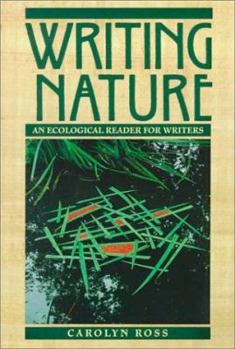Writing Nature: An Ecological Reader for Writers
This book asks students to analyze their writing using questions and exercises. Assisting with developing ideas and purpose in writing. This description may be from another edition of this product.
Format:Paperback
Language:English
ISBN:0312103913
ISBN13:9780312103910
Release Date:January 1995
Publisher:St. Martin's Press
Length:550 Pages
Weight:1.80 lbs.
Dimensions:1.0" x 6.1" x 9.0"
Related Subjects
Language Arts Nature Nature & Ecology Rhetoric Science & Math Words, Language & GrammarCustomer Reviews
1 rating
A Nature Writing Smorgasbord
Published by Thriftbooks.com User , 22 years ago
Imagine some of the world's best nature writers together in one room. You would include Emerson and Thoreau of course, and John Muir. And how could you leave out Rachel Carson or Aldo Leopold; Edward Abbey or Loren Eisely? A confident knock at the door and the trio of Annie Dillard, Barry Lopez and Peter Matthiessen appear, fresh from their various travels. A more deferential knock reveals some young unknowns, but they too are welcomed in. The conversation runs broad and deep. Names and influences from poetry to fiction; theology to philosophy; science to ethics fly about the room. You finally notice someone sitting in the corner with a dazed but euphoric look on their face, a smoking tape recorder and spilling notebook on their lap. It must be the editor of the volume here reviewed.For that is what Carolyn Ross has tried to do in this textbook. All of the writers and types of thinking mentioned above are included in this large volume (over 700 pages for the Instructor's Edition.) The purpose - and you'd be tempted to ask what more purpose than sheer collection you would need - is to analyse and dissect the ways in which these writers write. It is aimed at students and teachers of writing, with special emphasis on nature writing. "The goal . . . is to encourage students to understand their individual relationships to nature within a wider social context", writes Ross in the preface.The structure of the book is generally that writers are given their say via generous excerpts. The editor then asks students to analyse and interact with that writing through a series of questions and exercises. It is here that some learner-writers may suffer a "paralysis of analysis". Getting the "right people" to come to your party doesn't guarantee it runs smoothly. If too much earnest analysis gets in the way of real conversation, a party may bog down.Put another way, the book is at times too "right-brained". It tends to favour the "rules of writing" ahead of poetry; rhetoric ahead of contemplation. The encouragement to sit and look and smell and just soak up our subject, is usually outweighed by attention to rules. For instance, we are given the self-evident "rule" that "the most fundamental point the writer makes is an essay's central idea" (p. 82). This is then watered down when we're told that this central idea can be "implied through a dominant impression or mood" (p.83). It makes you wonder how useful the rule is in the first place. I tried it out on this piece by Karel Capek (not from this collection). "Storms murmur on the horizon, wind saturated with moisture springs up, and here it is: strings of rain hiss on the pavement, the earth almost breathes aloud, water gurgles, drums, pats, and rattles against the windows, tiptaps with a thousand fingers in the spouts, runs in rivulets, and splashes in puddles, and one would like to scream with joy, one sticks one's head out of the window to cool it in the dew from heaven, one whistles, shouts, and would like to





